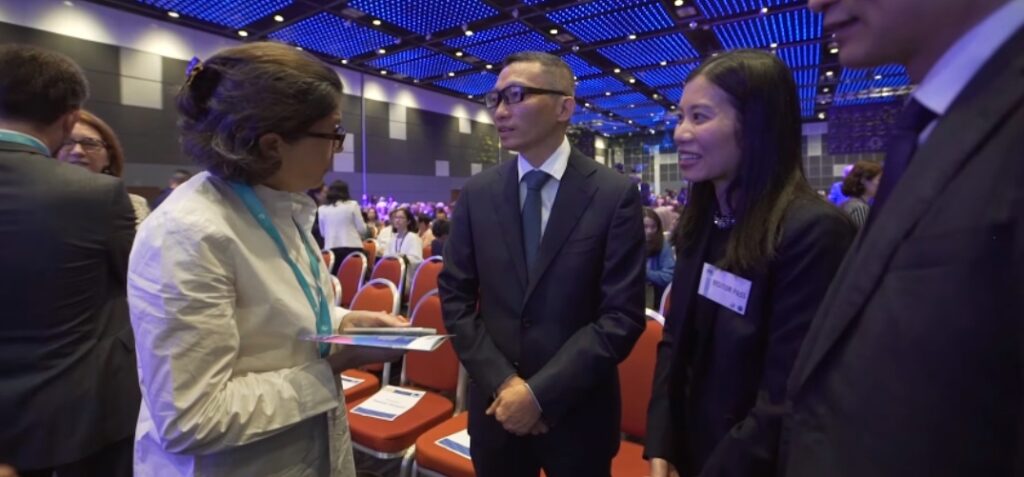In recent years, digital conferences have emerged as a popular and efficient alternative to traditional in-person events. The rise of novel communication technologies and the increasing need for remote collaboration have contributed to the growing demand for virtual events. Organizing a digital conference, however, requires a unique set of skills and strategies to ensure its success. So, how do you organize a digital conference?
Choosing the right digital platform, planning the conference agenda, and effectively promoting the event are essential to organizing a digital conference. Additionally, anticipating and preparing for technical challenges, engaging attendees during the conference, and conducting a thorough evaluation and follow-up after the event is crucial for maximizing the impact of the virtual experience.
By adopting a structured and comprehensive approach to organizing a digital conference, event planners can effectively bridge the gap between participants and create a meaningful and productive virtual space.
This article delves into the various aspects of planning and executing an effective digital conference, from determining the purpose and goals to evaluating and following up after the event.
Determine the Purpose and Goals of the Conference
Establishing the purpose and objectives of the conference serves as a crucial initial step in orchestrating a successful digital event. Goal setting and purpose clarity ensure that all aspects of the conference are developed with the intended outcomes in mind. With clear goals, organizers can make informed decisions about the conference format, content, speakers, and audience.
Moreover, purpose clarity helps streamline marketing and promotion efforts and measure the conference’s success after its conclusion. By identifying the primary objectives, organizers can tailor the event to meet the needs of the attendees and guarantee a valuable experience for all participants.
Choose the Right Digital Platform
To organize a successful digital conference, selecting the appropriate digital platform is crucial. A thorough comparison of features and pricing across different platforms is necessary to identify the most suitable option while considering the importance of compatibility and accessibility for all potential attendees.
Here we will delve into the key considerations for choosing the right platform, ensuring a seamless and engaging conference experience.
Comparing Features and Pricing
Careful evaluation of features and pricing is essential when selecting the most suitable platform for hosting a digital conference, as various options present distinct advantages and limitations. Organizers should prioritize platform security when assessing potential venues, ensuring that the chosen platform provides robust data protection measures and adheres to industry standards.
Additionally, organizers may wish to consider platforms that offer unique features, such as virtual swag, which can enhance the conference experience for attendees and provide opportunities for sponsors to showcase their brands.
Beyond these considerations, comparing features and pricing should include an examination of the platform’s user experience, ease of use, and scalability to accommodate the anticipated number of attendees.
In terms of pricing, organizers should weigh the value of the platform’s features against the cost, considering factors such as the availability of technical support, customization options, and integration with other tools.
Once a thorough comparison has been made, organizers can confidently select a platform that meets their specific needs and ensures compatibility and accessibility for all attendees.
Ensuring Compatibility and Accessibility
To guarantee a seamless and inclusive experience for all participants, it is imperative to meticulously evaluate the compatibility and accessibility features of the chosen hosting platform. Compatibility solutions should be examined to ensure that the platform is adaptable to various devices, operating systems, and browsers to accommodate the diverse range of attendees.
Furthermore, assess the platform’s ease of use, its ability to provide real-time technical support and the availability of resources such as tutorials and guides for participants to reference.
In addition to compatibility, accessibility improvements must be considered, including features such as closed-captioning, screen reader compatibility, and keyboard navigation options for individuals with visual or auditory impairments. Organizations can facilitate a more inclusive environment for all attendees by prioritizing these elements.
As the digital conference platform is selected and tailored to address compatibility and accessibility concerns, the focus can shift toward crafting an engaging and well-structured conference agenda. This includes determining session topics, scheduling presentations, and identifying suitable keynote speakers.
In doing so, organizers must be mindful of time zones and the variety of interests and expertise within the audience. By carefully considering these factors in the planning process, the conference will be poised for success and provide an enriching experience for all involved.
Plan the Conference Agenda
Meticulously crafting the conference agenda is pivotal in ensuring a seamless and engaging event experience for all participants. Agenda flexibility and time management are crucial aspects to consider when organizing a digital conference, as they contribute to the overall flow and effectiveness of the event.

To achieve this, organizers should allocate sufficient time for each session, considering potential technical difficulties and time zone differences. Additionally, providing breaks and interactive sessions will keep attendees engaged and prevent burnout while also offering ample networking opportunities. Strike a balance between informative presentations and interactive discussions, ensuring the agenda is comprehensive and appealing to a diverse audience.
Incorporating different topics and speakers can also contribute to a well-rounded conference agenda, thus attracting a wider range of attendees. To achieve this, organizers should consider including panel discussions, keynote speeches, and workshops and inviting industry experts, thought leaders and researchers to share their insights.
The agenda should be organized logically, with related topics and sessions grouped to maintain a coherent flow throughout the conference. Once the agenda has been carefully planned, organizers can focus on effective promotion and marketing to increase event visibility and attract more participants.
Effective Promotion and Marketing
Implementing strategic promotional and marketing efforts are essential in maximizing event visibility, attracting a diverse audience, and fostering a successful digital conference experience.
For instance, the upcoming digital marketing conference in Canada is a prime example of an event that has effectively utilized these strategies. Attending the digital marketing conference in Canada with invitation letter allows you to add a personal touch to the conference. The invitation letter also provides potential attendees with detailed information about the event.
Using digital promotion and marketing strategies, organizers can create a comprehensive plan to target potential attendees, engage with interested parties, and drive event registration. This approach should encompass various channels and platforms, leveraging the power of social media, email marketing, and content creation to generate buzz around the conference.
To evoke emotion in the audience and encourage participation, consider the following tactics:
- Craft compelling storytelling around the conference theme, showcasing the value and relevance of the event to potential attendees.
- Utilize visually appealing and engaging promotional materials such as videos, infographics, and interactive content to pique the target audience’s interest.
- Leverage influential speakers and partners to promote the event, highlighting their expertise and the unique insights they will bring to the conference.
By incorporating these marketing and digital promotion tactics into the conference planning process, organizers can ensure that their event is well-publicized and reaches the desired audience.
As the conference draws nearer, it is essential to shift focus towards preparing for technical challenges that may arise during the event.
Prepare for Technical Challenges
In the realm of digital conferences, addressing technical challenges is of paramount importance to ensure a seamless and productive event.
Ensuring a reliable internet connection and thoroughly testing audio and video quality before the conference is crucial to mitigating potential disruptions.
By taking these precautions, organizers can guarantee a higher level of participant engagement and satisfaction, ultimately contributing to the event’s overall success.
Ensuring Reliable Internet Connection
Securing a stable and robust internet connection is paramount for the seamless execution of a virtual event, as it directly impacts the overall experience of the participants and the effectiveness of the conference.
Organizers must implement necessary measures to optimize the internet connection, including assessing the bandwidth requirements, selecting a reliable service provider, and having backup plans. Moreover, share internet stability tips with attendees to ensure a smooth virtual experience for everyone involved.
To enhance the reliability of the internet connection during a digital conference, organizers should consider the following points:
- Assessing Bandwidth Requirements: Determine the minimum and recommended bandwidth for the platform being used, and ensure that the connection can handle multiple video streams, screen sharing, and other interactive features.
- Selecting a Reliable Service Provider: Research and choose an internet service provider with a reputation for stability and excellent customer support.
- Connection Backup Plans: Have backup options such as mobile hotspots, secondary internet connections, or a nearby coworking space to ensure the continuity of the event in case of connectivity issues.
- Sharing Internet Stability Tips With Attendees: Provide guidelines on optimizing their connection, such as using a wired connection, closing unnecessary applications, and turning off VPNs.
- Monitoring the Connection During the Event: Designate a team member to monitor the connectivity and address any issues immediately.
By implementing these measures, organizers can significantly reduce the risks associated with internet connectivity issues.
Ensuring a reliable internet connection sets the stage for the subsequent focus on testing audio and video quality to elevate the overall virtual event experience further.
Testing Audio and Video Quality
Apart from ensuring a reliable internet connection, another vital aspect of organizing a successful digital conference is testing and optimizing audio and video quality. High-quality audio and video are essential for effective communication and engagement during the conference.
To achieve this, organizers must conduct thorough audio troubleshooting and implement video enhancements before the event to prevent any technical issues that may disrupt the conference proceedings.
Audio troubleshooting involves testing microphones, speakers, and headphones for all presenters and participants and checking for any background noises or echoes that may negatively impact the conference.
Video enhancements comprise adjusting camera angles, lighting conditions, and video resolution to ensure clear and professional visuals. The following table presents a summary of key factors to consider when testing audio and video quality:
| Audio Troubleshooting | Video Enhancements |
| Microphone sensitivity | Camera angle |
| Speaker volume | Lighting conditions |
| Background noise reduction | Video resolution |
By addressing these factors, organizers can create a seamless and engaging digital conference experience for all attendees.
Engage Attendees During the Conference
Engaging attendees during a digital conference is essential for fostering a dynamic and collaborative learning environment. Encouraging live interaction and discussions using a conference event app can facilitate knowledge exchange among participants while offering networking opportunities can help build professional relationships and connections.
Implementing such strategies effectively can enhance the conference experience, ensuring that attendees derive maximum value from participating.
Encouraging Live Interaction And Discussions
Fostering real-time interaction and discourse is crucial in enhancing a virtual conference’s overall experience and effectiveness. Utilizing various tools and technologies to enable live communication and collaboration among participants can lead to more fruitful discussions and increased engagement.
Some of the effective methods to encourage interaction include virtual icebreakers, collaborative brainstorming sessions, and audience polling during presentations.
- Virtual Icebreakers: These activities can be used at the beginning of the conference to help participants get to know each other and feel more comfortable in the virtual environment. Examples of virtual icebreakers include quick introductions, trivia games, or sharing interesting facts about oneself.
- Collaborative Brainstorming: By incorporating collaborative brainstorming sessions during the conference, attendees can actively contribute to discussions, share their ideas and opinions, and work together to solve problems or create new projects. This can be facilitated through shared documents, virtual whiteboards, or breakout rooms in video conferencing platforms.
- Audience Polling: Introducing live polls during presentations allows participants to share their thoughts and opinions on a particular topic, giving the presenter valuable feedback and promoting active involvement from all attendees.
As interaction and discussions are essential components of a successful digital conference, it is equally important to create opportunities for attendees to connect and network with each other.
Offering Networking Opportunities
Transitioning from encouraging live interaction and discussions, another crucial aspect of organizing a digital conference is offering networking opportunities. Networking plays a vital role in professional growth and relationship building, so facilitates meaningful connections between attendees, even in a virtual environment.
Incorporating virtual icebreakers and networking games can help attendees feel more comfortable and engaged while interacting with one another, paving the way for fruitful discussions and potential collaborations.
One way to provide networking opportunities at a digital conference is by incorporating dedicated networking sessions and spaces within the event platform. These sessions can be structured around specific topics or industries, allowing attendees to connect with those who share similar interests.
Virtual icebreakers can be used to create a relaxed atmosphere and encourage conversation among participants. Furthermore, networking games can be designed to facilitate introductions, foster teamwork, and create memorable experiences.
The following table presents a few examples of networking opportunities that can be employed during a digital conference:
| Networking Opportunity | Description | Outcome |
| Virtual Icebreakers | Short, interactive activities that help attendees get to know each other and create a comfortable environment for conversation. | Enhanced attendee engagement, increased comfort level for conversation, and a more relaxed atmosphere. |
| Topic-Based Networking Rooms | Dedicated virtual spaces for attendees to discuss specific topics or industries; participants can join the rooms that align with their interests. | Focused conversations, connections made based on shared interests, and potential collaborations. |
| Speed Networking | Attendees participate in short, one-on-one conversations with multiple participants, typically within a set time limit. | Quick introductions, increased number of connections made, and efficient use of networking time. |
| Networking Games | Interactive games designed to facilitate introductions, foster teamwork, and create memorable experiences. Examples include virtual escape rooms or team-based trivia challenges. | Team-building, increased attendee interaction, and enjoyable networking experiences. |
| Post-Event Networking Follow-Up | Encourage attendees to connect with each other after the event through the event platform or social media channels, fostering ongoing relationships and collaboration. | Continued networking, strengthened relationships, and potential collaborations post-event. |
Incorporating these networking opportunities not only enhances the overall experience for attendees but also contributes to the success of the digital conference. As organizers prepare to evaluate and follow up after the conference, these networking initiatives can serve as a valuable metric for measuring attendee satisfaction and engagement.
Evaluate and Follow-Up After the Conference
Post-conference evaluation and follow-up is like the final puzzle pieces that complete the picture, as they offer valuable insights into the event’s success and areas of improvement for future digital gatherings.
Utilizing post-event surveys and feedback analysis allows organizers to gauge attendee satisfaction, identify strengths and weaknesses, and determine the overall effectiveness of the event. Collecting this data through various digital platforms, such as online survey tools and social media channels, can help conference planners to make informed decisions about future events, including content, delivery, and networking opportunities.
A thorough follow-up process should involve not only the analysis of feedback data but also the establishment of communication channels with attendees and stakeholders. This can include sending out thank you notes, sharing conference highlights, and providing access to recorded sessions and resources.
Additionally, organizers can use the post-conference period to build and maintain relationships with sponsors, exhibitors, and speakers, ensuring their continued support and involvement in future events. By engaging in a comprehensive evaluation and follow-up process, the organizers can better understand the needs and expectations of their audience and work towards creating more successful and engaging digital conferences in the future.
Conclusion
Organizing a digital conference demands a comprehensive approach, ensuring it meets its objectives and engages participants effectively. The entire process encompasses selecting an appropriate platform, devising a well-structured agenda, addressing technical challenges, and employing efficient promotional strategies.
A noteworthy statistic to consider is that, according to Global Workplace Analytics, around 56% of the workforce holds a job that can be done remotely. As digital conferences become increasingly prevalent, mastering the art of organizing and conducting such events will be indispensable in the evolving professional landscape.








